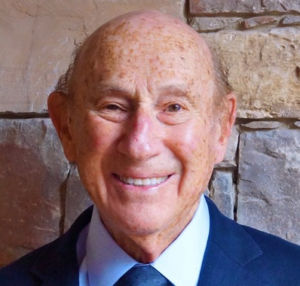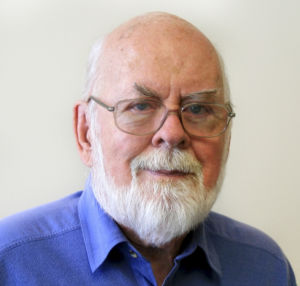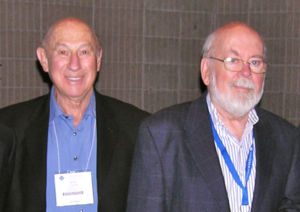The Pariser-Parr Lectureship
The Pariser and Parr families established the annual Pariser-Parr Lecture to bring influential and cutting-edge researchers to UNC to give UNC students an opportunity to hear research they may not otherwise have a chance to learn.
We thank them for their generosity, and look forward to more lectures to honor Dr. Pariser and Professor Parr for all of their groundbreaking work at UNC and beyond.
Dr. Rudolph Pariser
 Rudolph, Rudy, Pariser, after graduating in Chemistry from Berkeley in 1944 and after two years service in the army, earned his Ph.D. in 1951 at the University of Minnesota under Prof. Robert Livingston. His thesis was on Chlorophyll photosensitized reactions in solution. He also first met Robert G. Parr at Minnesota, having taken a course taught by him in thermodynamics. Professor Parr was finishing his Ph.D. in 1947, about when Dr. Pariser arrived.
Rudolph, Rudy, Pariser, after graduating in Chemistry from Berkeley in 1944 and after two years service in the army, earned his Ph.D. in 1951 at the University of Minnesota under Prof. Robert Livingston. His thesis was on Chlorophyll photosensitized reactions in solution. He also first met Robert G. Parr at Minnesota, having taken a course taught by him in thermodynamics. Professor Parr was finishing his Ph.D. in 1947, about when Dr. Pariser arrived.
Upon graduating from Minnesota, Dr. Pariser joined Du Pont’s Jackson Laboratory. At that time, most of Jackson Laboratory was heavily engaged in developing dyes for the new Du Pont fibers, such as Nylon, Dacron, Orlon, Lycra. Being a physical chemist, Dr. Pariser proposed that he might provide help to the synthetic effort through a better understanding of the color of dyes vs. their structure. He remembered a quote by Dirac about quantum theory that stated: “The underlying physical laws for the mathematical theory of a large part of physics and the whole of chemistry are thus completely known.” He did not remember the concluding phrase: “…and the difficulty is only that the application of these laws leads to equations much too complicated to be soluble.” Thus, for his assignment, Dr. Pariser proposed and gained approval to initiate work toward the theoretical relationship between dye structure and its color.
Dr. Pariser knew that Professor Parr had done his thesis work on quantum mechanical calculations of benzene, and he gained approval to engage Professor Parr as a consultant to help him in his new assignment. Little did he know at the time that the Professor’s arduous ab initio calculations showed essentially no agreement with the experimental spectrum, or energy levels, of benzene. Dr. Pariser visited Professor Parr at Carnegie Tech where Parr was a recent Assistant Professor and he proposed to engage him as his consultant toward calculating the spectra of complex dyes. It is to Professor Parr’s great credit that, without hesitation, his response was: “Let’s get started!”
Soon after commencing their collaboration, Professor Parr discovered the “Zero Differential Overlap Approximation” which dramatically simplified the calculation. Essentially, the same results for benzene as in Parr’s thesis could now be calculated very easily. However, in order to achieve agreement with experiment, Dr. Pariser discovered that the values of “inter-electronic repulsion integrals” needed significant adjustment, which was a key aspect of the calculation. He developed a method based on the use of known atomic ionization potentials and electron affinities to adjust these integrals. Then, being the first chemist to use IBM’s revolutionary fully transistorized IBM 701 “supercomputer,” Dr. Pariser developed a program, using “machine language,” to perform such calculations His results for the polyacenes, Naphthalene through Pentacene, were in very close agreement with experimental values such as were known, and he predicted as yet undiscovered excited states, for ex-ample triplet states, which were then experimentally con-firmed. In recognition of subsequent contributions by John Pople, the theory became known as the Pariser-Parr-Pople theory, or PPP theory, and continues to receive wide application.
Dr. Pariser was also active in the National Research Council of the National Academy, heading a report on Polymer Science and Engineering, as well as several others, and served on the Small Business Innovation Program. He was the recipient of the First ACS Delaware Section Award and of the U of Minnesota “Gold Medal;” he was elected Fellow of AAAS and of IUPAC. In 2003 he was honored by the Lavoisier Medal, Du Pont’s highest technical award. He was a leader in CHEMRAWN, Chemical Research Applied to World Needs, an IUPAC activity, organizing conferences world wide. He served as Associate Editor of the Journal of Chemical Physics, Chemical Physics Letters, and the Journal of Polymer Science. He also served on numerous university advisory boards and traveled on advisory missions to China, soon after its “opening” in the 1970’s, and to South Korea, Egypt, Japan and Israel.
Dr. Pariser completed his career at Du Pont as Science Director in Central Research. He retired from DuPont in 1988 and formed R.Pariser & Co.,Inc., consulting in R&D management. He passed away in 2021, but was active in Sigma Xi and on several advisory boards, including the Board of Overseers at the Chemical Heritage Foundation, and the Advisory Board for the Department of Chemistry at UNC until his passing.
Dr. Robert G. Parr

Professor Emeritus, Robert Ghormley Parr, passed away on March 27, 2017, after a brief illness.
Professor Parr received an A. B. degree magna cum laude from Brown University in 1942, and then entered the University of Minnesota, receiving a Ph.D. in physical chemistry in 1947. He joined the faculty at Minnesota upon receiving his doctorate, and remained there one year. In 1948 he moved to the Carnegie Institute of Technology, now Carnegie Mellon University, in Pittsburgh, Pennsylvania, becoming a full professor in 1957. In 1962 he moved to Johns Hopkins University in Baltimore, Maryland, and in 1974 to the University of North Carolina at Chapel Hill, where he received appointment to an endowed professorship in 1990 and where he last taught.
Professor Parr was a pioneer the field of ab initio quantum chemistry since the 1950’s. His book entitled Quantum Theory of Molecular Electronic Structure, Benjamin 1963, was most influential at that time. Professor Parr constructed the zero-differential overlap approximation and later, with Pariser and added by Pople, developed the influential Pariser-Parr-Pople, PPP, method. The PPP method was a landmark in the development of quantum chemistry and is still very widely used. In the early seventies, Professor Parr had the vision to realize that density-functional theory, DFT, could very well turn out to be the method of choice for quantitative calculations on systems of chemical and biological interest, especially for those with large numbers of electrons. Professor Parr had the foresight to begin his research in DFT long before it was as popular or as fashionable as it is today in the chemistry community. In fact, for years Professor Parr was virtually the only chemist of his generation to pursue DFT. He had the courage to do this despite the fact that he was often criticized, and even ridiculed at times, for it.
Professor Parr led the research community in the construction of approximate functionals for practical applications in chemistry. The Lee-Yang-Parr correlation energy functional,


